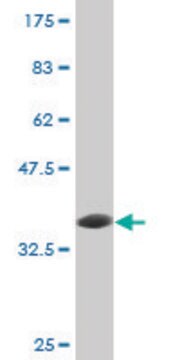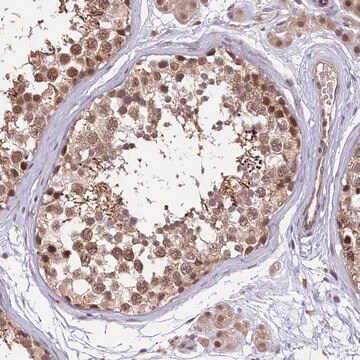E8655
Anti-E6AP antibody, Mouse monoclonal
clone E6AP-330, purified from hybridoma cell culture
Sinónimos:
Anti-E2F-6
About This Item
Productos recomendados
origen biológico
mouse
conjugado
unconjugated
forma del anticuerpo
purified from hybridoma cell culture
tipo de anticuerpo
primary antibodies
clon
E6AP-330, monoclonal
formulario
buffered aqueous solution
mol peso
antigen ~100 kDa
reactividad de especies
human, mouse, rat, monkey
técnicas
immunocytochemistry: suitable
immunoprecipitation (IP): suitable
indirect ELISA: suitable
microarray: suitable
western blot: 1-2 μg/mL using total cell extract from 293T cells
isotipo
IgG1
Nº de acceso UniProt
Condiciones de envío
dry ice
temp. de almacenamiento
−20°C
modificación del objetivo postraduccional
unmodified
Información sobre el gen
human ... E2F6(1876)
mouse ... E2f6(50496)
rat ... E2f6(313978)
Descripción general
Monoclonal Anti-E6AP antibody is a useful tool for the study of E6AP and its function in protein degradation. This antibody is specific for E6AP protein in rat, mouse, human and monkey.
Inmunógeno
Aplicación
Forma física
Cláusula de descargo de responsabilidad
Not finding the right product?
Try our Herramienta de selección de productos.
Código de clase de almacenamiento
10 - Combustible liquids
Clase de riesgo para el agua (WGK)
nwg
Punto de inflamabilidad (°F)
Not applicable
Punto de inflamabilidad (°C)
Not applicable
Certificados de análisis (COA)
Busque Certificados de análisis (COA) introduciendo el número de lote del producto. Los números de lote se encuentran en la etiqueta del producto después de las palabras «Lot» o «Batch»
¿Ya tiene este producto?
Encuentre la documentación para los productos que ha comprado recientemente en la Biblioteca de documentos.
Nuestro equipo de científicos tiene experiencia en todas las áreas de investigación: Ciencias de la vida, Ciencia de los materiales, Síntesis química, Cromatografía, Analítica y muchas otras.
Póngase en contacto con el Servicio técnico








